Best relationships are built through bonding and mutual care. Promoting care and interest in your customers’ needs is one of the best practices which can help you establish firm and healthy relationships and ensure that your customer base will grow.
Showing tender loving care to your customers by simply asking for their opinion, can improve customer retention and can help businesses thrive.
You have heard the saying: “The customer is always right! “
That is why the moment is now to call for your customers’ honest opinions and show how much you care about their overall experience with your company.
In this customer-centric world, your customers’ feedback holds great significance. Businesses should seize every opportunity to gather feedback from their customers to make important and informed decisions. This doesn’t include just communicating with them on social media.
Whether your customers have a negative or positive experience, we should always welcome their feedback. They can point out some mistakes that you may not have been aware of.
Nevertheless, even if the feedback is negative, there is no need to be disappointed; everybody deserves a second chance.
In this blog post, we discuss why and when to create a customer feedback survey to further understand your customers’ needs. We also show you simple customer satisfaction survey examples that you can start using today.
Let’s dive in!
What’s inside?
- What is a customer feedback survey, and why is it important?
- How can customer feedback surveys help your business?
- Types of customer satisfaction survey questions
- Net Promoter Score (NPS) Survey
- Customer Satisfaction Score (CSAT) Survey
- Customer Effort Score (CES)
- Post-Purchase Survey
- Usability Survey
- Bonus tips for asking the right questions
What is a customer feedback survey, and why is it important?
For the businesses to operate like one big, happy family, they need to be aware of all the family members’ desires, needs, and requirements.
Customer feedback surveys are powerful and straightforward measurement tools that help examine overall customer satisfaction. The survey’s primary purpose is to collect data on a specific group of people (in this case, your customers) and help you gain insights and useful information on a particular topic.
Your customers are the ones who use your products and go through the full buying process, so the answers they provide are the most relevant and helpful information you can gather about your business.
How can customer feedback surveys help your business?
The customer journey is a wild one, and many challenges may appear on the path of getting to the final destination. As a business, you should remove all obstacles and provide an easy, smooth, and enjoyable experience for your customers.
Surveys are specially designed to help you identify the challenges that users may be facing, gather valuable data, better your business, attract new customers, and keep the old ones.
Do you want your customers to feel like they mean something to you?
– “Sure you do!”
Ask them how satisfied they are with your product or service? Nothing screams more I CARE ABOUT YOU than a simple question about their experience with your business.
Types of customer satisfaction survey questions
First, set a goal before running a survey.
Ask yourself, what do you want to discover?
- Do you want to know how satisfied your customers are?
- Is the customer support meeting your clients’ expectations and providing a good service?
- Is the checkout process easy enough for your customers? What is the demographic that visits your website the most?
Several types of surveys can provide you with the answers you are looking for.
Depending on your research goal, one of the following surveys should fit you perfectly.
1. Net Promoter Score (NPS) Survey
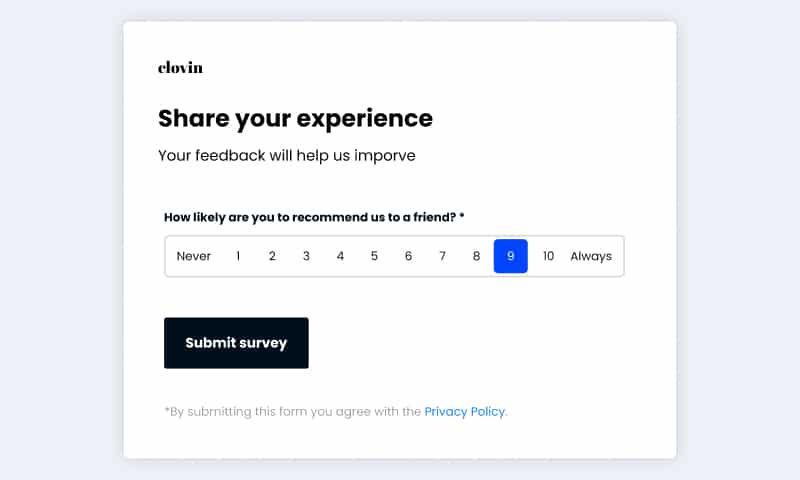
Why:
- One-survey questions that can give you insight into whether the customers are happy or not.
- Short and easy to answer
- High response rate
When:
- Right after purchasing a product or service
Net Promoter Score is a universally and generally used method of analyzing your customers’ loyalty and satisfaction. It’s a relatively popular and straightforward online survey that calculates the customer likelihood of recommending you to a friend or a colleague.
Customers can rate their level of satisfaction from 0-10.
Depending on the answers to the NPS survey, the respondents are classified into three groups:
⦁ Detractors – customers who gave a grade from 0 to 6. These customers are not happy with your business and would probably not recommend you to anyone.
⦁ Passives – customers who rated you from 7 to 8. These customers are relatively satisfied. They can turn into loyal customers, but also they can turn around and leave.
⦁ Promoters – These are the best ones! These are the ones who gave the highest scores and would definitely recommend you to a friend or colleague.
It is a clear indicator that your business is on the right track if the rating scale is full of customers who would gladly spread the word about how satisfied they are with your business. That being, said NPS surveys are like a sneak peek into the future of your business growth.
Nonetheless, if the scores are lower than you expected, you can always follow up with a question asking your customers to elaborate their answer.
2. Customer Satisfaction Score (CSAT) Survey
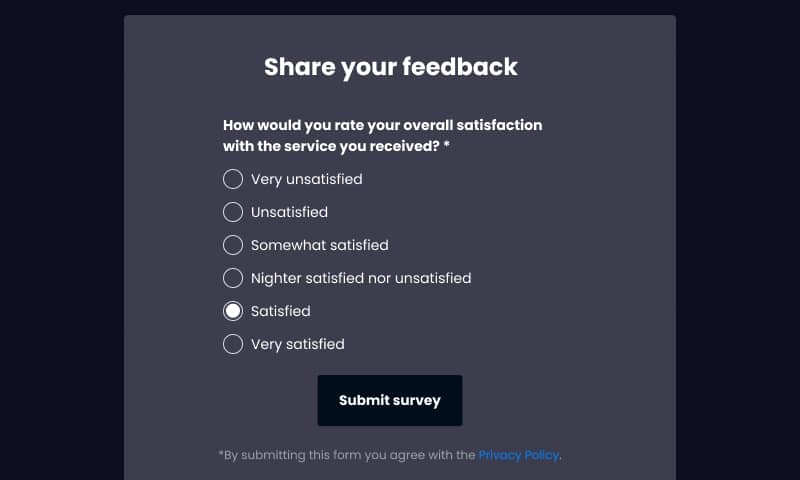
Why:
- Perfect for a specific product/service
- It acts like a KPI measurement that shows you how far you’ve come in meeting your customer expectations
- Short and understandable
When:
- The best time to use customer satisfaction score surveys is the moment you decide to measure customer satisfaction for a specific product, service, or part of your business.
Suppose you launched a new product or service that you are very proud of. You are burning with the desire to find out if your customers love the product as much as you do.
CSAT It is an ideal questionnaire for determining how satisfied your customers are with a particular product or service.
Customers are offered a scale with a few options ranging from very unsatisfied to very satisfied, which will reveal the truth about your customers’ feelings.
There is no limitation on the number of questions, and you can use both closed-ended and open-ended questions if you think it’s necessary.
Customers whose survey responses were very satisfied and satisfied can be considered happy buyers.
The other responses initiate the need for improvement.
If you are unsure what type of questions to ask your customers, here are a few ideas to get inspired.
- How would you rate the overall satisfaction with our product/service?
- How satisfied are you with our product/services?
- How often do you use our product?
- How do you use our product/service?
3. Customer Effort Score (CES)
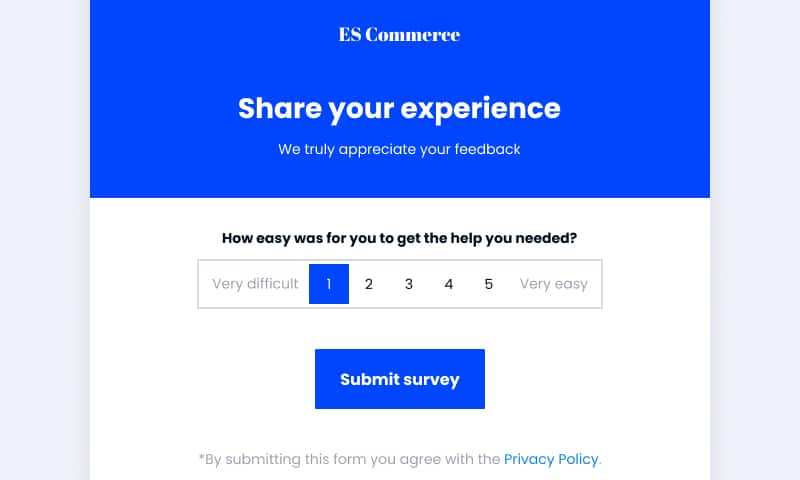
Why CES:
- It’s a precise measurement tool for understanding exactly the effort put into using your product or service.
- Trustworthy method for predicting customer behavior.
When to use:
- Right after a specific touchpoint in time, like purchasing a product.
An effort is not a bad thing when we try to achieve something, but here in e-commerce, we try to keep it at the lowest level.
Customer effort score it’s a handy survey that shows how easy it is for your customers to use your product or service.
To run an effective and clear CES survey, which will emphasize the effort, the questions need to include the two most important keywords: how easy.
Here is what we mean:
- Overall how easy was it to solve your problem with our service/product?
- How easily the support team helped you solve the problem?
Consequently, the answers would be: very easy, easy, neither, difficult or very difficult.
4. Post-Purchase Survey
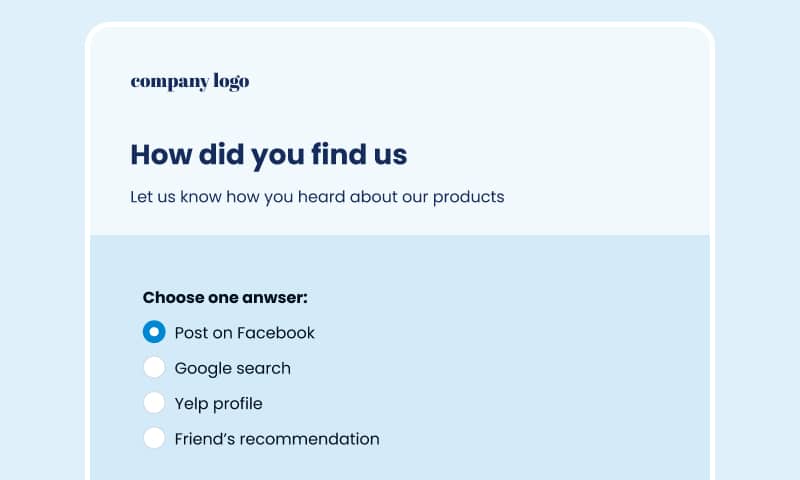
Why post-purchase survey:
- Can pinpoint specific parts of your business that need improvement
When to use:
- The goal is to ask for customer feedback as soon as possible after a purchase is made.
You’ve made it! A customer has made a purchase, and now you can finally celebrate this glorious moment of triumph!
As amazing as it sounds, you still need to gather valuable customer feedback and try to get your hands on every little bit of information.
How do you do that, you may ask?
By simply running a post-purchase survey. These questionnaires are mostly used to collect information about a specific moment in time through the customer journey.
The main goal is to use the feedback smart and improve your website, product, service, or marketing strategy.
Here are a few questions you can include in your survey to collect feedback for your business’s specific part.
- Are you satisfied with the quality of the product or service?
- How did you find us?
- Was the checkout process easy for you?
- How quickly did you receive the ordered product?
Depending on the questions you choose, and the goal you want to achieve, the Likert scale and multiple choice answers can be a good answer-option to gather the answers you are looking for.
5. Usability Survey
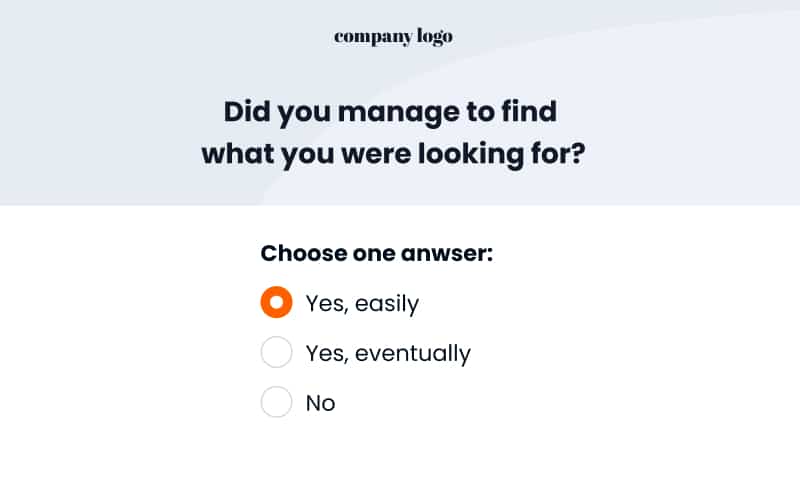
Why usability survey:
- Find out how customers navigate through your website.
- Find out whether they found what they are looking for
- Find out whether they achieved their goal.
When to use:
- There is no set period when exactly a usability survey should be conducted.
- Keep in mind that you need to ask your customers for feedback when using your website.
To deserve the title good website, one must put an incredible amount of effort and pay attention to many thighs like good organization, nice web design, easy navigation, and everything that contributes to a good customer experience.
Usability survey is used by online businesses that aim to understand the user’s experience on their website. These surveys contain questions about web design, web navigation, website content, page performance, and everything in between.
Since websites are the face of online companies and the main place where customers make their purchases, the high functionality and easy usability are of great importance.
The usability survey can help you identify if customers face any issues when they visit your website.
Here are few questions to include in your usability survey:
- Do you find our website mobile-friendly?
- Do you like the design?
- Did you manage to find what you were looking for?
- Do you have any other suggestions?
Bonus Tips for asking the right questions
So far, we have seen examples of several metrics and different types of questions, but now we need to pay attention to the dos and don’ts when running a survey.
- When writing down questions, try using precise formulations. This means that you shouldn’t use words that are not familiar to users. If they don’t understand the questions, then they won’t be able to give truthful answers.
- Avoid asking too long and suggestive questions.
- Choose the right medium and place the survey where your audience is most concentrated.
- Pay attention to the design. Use colors inherent in your brand, this way, you will give more credibility to your survey.
To sum up
Don’t be afraid to ask all the questions that trouble you at night; the best answers come from a first-hand source, and that is your customers.
Think about which aspect of your business needs improvement and choose one of the surveys to gather your customers’ feedback.
The answers are right in front of you, the only thing you should do is ask!


